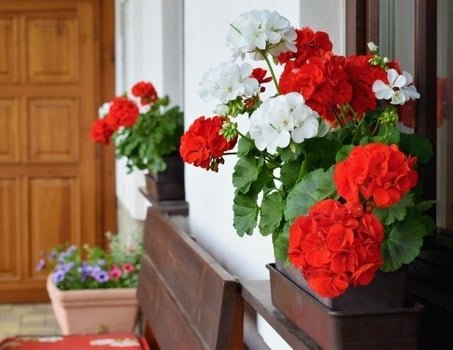Gardeners understand that there are indoor and outdoor plants that can keep pests away. Some shrubs stop mosquitos from bothering you while you work in the yard, and flowering plants that keep aphids and other pests from eating your vegetables. But, can any plants keep bed bugs away?
It may be that house and patio plants containing geraniol keep bed bugs away. Examples include lemongrass and geraniums. Lavender is proven to repel insects, but is more effective when distilled and applied directly. Plants are an ineffective control method because bed bugs live indoors.
The validity of the idea that certain plants repel pests has been questioned by scientific studies. As such, using less traditional means like sprays and fumigation is considered a better option.
Why Do Plants Repel Bed Bugs?
Bed bugs are lured by three key things. Carbon dioxide is one, which we exhale, so that the air around us contains more CO2 than regular air. They’re drawn in by heat, which we give off at night.
But what’s less well understood is how they’re drawn to the smell of people. Various tests have been done to test the idea. We know, for example, that bed bugs are drawn to worn clothes rather than clean clothes. So, there’s something about the smell of people that attracts bed bugs. If they can find a person, they can feed.
Insects and more developed animals alike have learned to avoid things that smell ‘bad.’ Just like we are drawn to scents that are good for us, like food, we’re also repelled by the smells of things that would be bad for us. Noxious chemicals that would kill us if we ate them smell bad to us, so that we’ll naturally avoid them.
The same applies to animals and the plants that could hurt them. A grazing deer or cow that doesn’t understand that it shouldn’t eat certain kinds of poisonous plants would quickly die, without being able to pass on its genes. That’s how natural selection helps create animals that avoid certain plants, or are drawn to others.
Do Geraniums Repel Bed Bugs?
Geranium contains a chemical called geraniol, which is the basis of/included in several essential oils including geranium oil, lemon oil, rose oil, palmarosa oil and citronella oil.
Geraniol derived from natural sources is a genuine bed bug repellent. It’s included in EcoRaider, a commercially available bed bug spray. EcoRaider has been shown in clinical studies to be just as effective as synthetic insecticides.
There are several hundred different species of geranium. The majority are small bushy plants, each with different colored flowers. Some are bright red, some bright pink. Others head through the spectrum—there are light pinks and vivid purples, light blues and royal blues. Others are two-tone.
So, aside from potentially repelling bed bugs, they’re pretty plants, too. To maximize their effect, you could keep them indoors. Geranium isn’t the best-known indoor plant, but will thrive in a position where it gets enough light.
Does Geraniol Repel Bed Bugs?
Geraniol is proven to repel bed bugs. The study linked above looked at a commercial spray that contained other active ingredients, but other studies focus specifically on geraniol itself. This one from the Journal of Vector Ecology tested candles and diffusers that contained geraniol, which effectively repelled mosquitos both indoors and outdoors. In light of the study above, it’s likely to have the same effect on bed bugs.
However, the geraniol used in these experiments was pure, and applied or released directly where it was needed. While lemongrass and geraniums both contain geraniol, they don’t necessarily emit it like a diffuser or candle, let alone apply it directly like the EcoRaider spray.
Can Geraniums Keep Bed Bugs Away?
However, there’s a good reason to think that geraniums don’t work as we think they might. A paper in the Journal of the American Mosquito Control Association looked specifically at Pelargonium citrosum, a kind of geranium specifically marketed as the ‘mosquito plant.’ It’s supposed to give off a scent that keeps mosquitos away.
Researchers found that “…not only was the plant ineffective at protecting humans against Aedes mosquito bites, the mosquitoes were seen landing and resting on the citrosa plant regularly.” While this study only looked at one species of geranium, it wasn’t a promising result.
The point is that chemicals like geraniol are found in the leaves, roots, and stems of plants like these. The plant doesn’t always give them off. Creating essential oils—distilling these chemicals—is a specific process that takes time. It’s like how you need flour to bake a cake, but eating flour on its own wouldn’t be all that tasty.

Is Lemongrass a Bed Bug Repellent?
Lemongrass is the source of citronella oil, which contains geraniol. So, lemongrass contains geraniol too. Lemongrass is a genus, containing many different species, from both Africa and Asia.
As per its name, it’s a kind of grass. You’ve probably seen it before: it’s tall and spiky, and the leaves reach up before curving back down toward the ground. It can reach five foot in height.
You can grow lemongrass anywhere you like, but it doesn’t like frost. In the wild, it prefers tropical weather, but it’s a grass which means it’s hardy. If you live somewhere that gets frost in the winter, you should grow it in a pot that you can move indoors when it gets too cold. If you want your yard to look pretty, lemongrass is a good choice for borders and backgrounds.
However, the supposed effective ingredient in lemongrass is geraniol. As we alluded to above, geraniums don’t give off geraniol into the air. Or, at least, they don’t to a degree that actually wards off pests. As such, it’s highly unlikely that lemongrass would have any effect on the bed bugs infesting your home.
Does Lavender Really Repel Bed Bugs?
Lavender may keep bed bugs away, but specific evidence for that is quite thin on the ground. Lavender is insecticidal, and insecticides generally double as repellents.
A paper in Research in Veterinary Science found that lavender oil killed poultry mites on contact, for example. A promising result, no doubt, but there were caveats.
The team behind the study were looking for a natural insecticide, since insects (poultry mites included) are increasingly becoming immune to synthetic ones. To test lavender oil, they first doused a filter paper in it, before putting it in a sealed Petri dish.
When the mites were introduced to it immediately, between 66% and 90% of them were dead within 24 hours. However, they also tested to see what would happen if they soaked the filter paper in lavender oil and didn’t seal it away afterward. They left it to ‘fume’ for 24 hours, before then placing it in a Petri dish and repeating the same experiment. Only 11% of the mites died.
There are many things to take away from this experiment. First, using lavender in the open air makes it far less effective. Commercial sprays are designed to last for weeks when sprayed on surfaces. Second, this is the closest thing there is to prove that lavender itself has any effect on bed bugs.
Unfortunately, it’s challenging to find any information on the topic because of all the blogs and forums out there that claim things work when they don’t. We can say that lavender has some effect. But there are better options out there.
Cinnamon and Bed Bugs
You might not know that cinnamon is a kind of tree. Cinnamon (the spice) comes from the inner bark of Cinnamomum trees. There are over 300 species of cinnamon tree, and they’re found all across the world, including every part of the Americas, Asia, Oceania, and Australia.
The trees grow to 5 feet or so indoors, or 30 feet or more outdoors, depending on how well-adjusted they are to the local environment.
Like lavender, it’s thought that cinnamon can repel certain insects. It’s proven to kill mosquitos and their larvae on direct contact, for example. However, cinnamon is derived from the inner bark of cinnamon trees. It’s not ‘given off,’ or anywhere that the insects could access it.
This makes it less likely that it would have any real effect. Plus, cinnamon trees (and trees generally) are much harder to grow than plants.
Marigolds and Pests
Marigolds are a flowering plant in the sunflower family. They have big, broad orange or yellow flowerheads that look great in any yard or garden. But aside from looking good, marigolds can repel pests. They’re an effective natural pest repellent that can be grown alongside common crops to keep aphids and their larvae away, as well as moths, butterflies, and flea beetles.
As for whether they could repel a bed bug—it’s likely that they could, but not proven. Insects of different species are often repelled by the same things. Lavender, for example, can repel mites, bed bugs and mosquitos: three unrelated species.
So, it’s not a stretch to think that marigolds could too. Do bear in mind, though, that it hasn’t been specifically proven.
Does Mint Repel Pests?
Like several of the other options here on our list, you can distill essential oil from the mint. Peppermint oil is used in natural mosquito repellents, just like lavender, Geraniol, and tea tree oil. You’ll typically see it in ‘DEET-Free’ insect repellents, and featured on countless home care blogs.
Unfortunately, the same applies to mint as applies to lavender, lemongrass, and geraniums. It’s not clear that these plants actually give off any of their natural ingredients, and would keep bugs away.
Does Citrus Repel Bed Bugs?
Citrus is well-known for repelling insects, and can even keep cats from your yard. Citrus leaves also either contain lemon oil, or something like it, lemon oil being one of the oils we mentioned above that may have a repellent effect. But does it work?
Surprisingly, there are few people online who seem to think it works. Considering that most other oils are recommended for killing just about any insect, it’s odd that nobody thinks the same of lemon oil.
Citrus juice, on the other hand, may have an effect. Some people think that lemon juice can repel mosquitos, fleas and other creepy crawlies.

Can Plants Keep Bed Bugs Away?
The problem is that to think the plants in your yard could keep bed bugs away is most likely wrong. It’s down to a misconception about how bed bugs get into our homes. Just think of cockroaches. Cockroaches can survive at any temperature, from Arctic cold to tropical heat. They can live indoors and out, and can travel quickly. It’s possible that they could come from a neighbor’s house, scuttling across the road or through your yard, and find their way to you.
Bed bugs are an entirely different kind of insect. They can’t survive outside for a long period of time because they can’t feed on anything but people, and people that are still, at that. Freezing temperatures won’t kill them straight away, but will eventually. To catch bed bugs, you have to physically carry them into your home with you in your bag or your clothing. Or, of course, somebody else who shares their home with them could accidentally share them with you.
At no point in the process do bed bugs have to go into your yard? They’re indoor pests. They hide indoors, they feed indoors, they digest indoors, and they mate indoors. This greatly reduces the efficacy of using plants to repel bed bugs.
Using Plants to Repel Bed Bugs
If you want to use plants to repel bed bugs, there are a few ways you could do so. First, and most obvious, is to try growing some of these plants indoors. In particular, you should look to grow them in your bedroom, as close to your bed as you possibly can.
Alternatively, you could try cutting off sprigs of these plants and keeping them near your bed. You could even put the sprig underneath your mattress, wherever you can see the most bed bugs.
This has the bonus of releasing sap or fluid from where you cut the stems, which may increase the availability of chemicals like geraniol in the air. Whatever you do, though, you won’t achieve the same effects as you would if you used the distilled or improved form of the chemicals in these plants that supposedly repel bed bugs.
That’s what science is for, taking something from nature and improving on it or isolating the chemicals that cause positive effects. Take penicillin for example. You might not know that it was originally discovered in a mold called penicillium, which scientists discovered had antibacterial effects. They then isolated what actually caused the antibacterial effect, before testing it on both animals and people to prove its effects. Now, we have penicillin, one of the best antibiotics.
The same applies to the use of plants to kill bed bugs. Instead of using the plants themselves, use what people have derived from them. The oils and decoctions made from those plants are much more effective.
Do Plants Attract Bed Bugs?
If some plants repel bed bugs, it might make sense that there are some which attract them too. Lilies, for example, are known to attract house flies, as well as butterflies and bees. Solomon’s Lily, the species with the largest flowers in the world, releases a scent that mimics the smell of rotting fruit to attract fruit flies.
However, it’s unlikely that any plant might attract bed bugs in the same way. Solomon’s Lily attracts fruit flies because those fruit flies will fly to another flower, taking pollen with them. The same applies to the bees and butterflies that other lilies attract, with other sugary scents.
It’s feasible that a plant could attract a bed bug. Bed bugs are lured in by the scent of human skin and carbon dioxide, so any flower that could give off either would attract them. But there would be no point. Bed bugs are an indoor pest, so they don’t interact with flowers or plants.
They, therefore, wouldn’t carry pollen from one plant to another, which is the whole point. That’s why there aren’t any plants that attract bed bugs.

